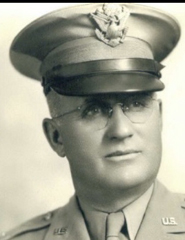Sgt. Jas. R Ganoe, Scranton, Helped Clear Way to Heister
By Frank Miles
(Daily Times Herald War Correspondent)
In Germany (IDPA) -- Sgts. James R. Ganoe, Scranton, and James J. Constantine, Fort Dodge, were in a 78th "lightning'" division platoon, which helped take the town of Heister, east of the Rhine, in jigtime. Orders were to charge across 200 yards of open ground to reach what ever buildings might be used to pour fire on the Jerries.
Constantine cleared the way for his comrades by cutting a wire fence while under fire. The platoon took 35 prisoners in one house. A German captain insisted he would not surrender to enlisted men; that in deference to his rank, he must be allowed to give himself up to an American officer. He changed his mind.
Two tanks leveled structures assisting the fighters. Going into the town, a corporal kicked open a farm house door. He found 25 German soldiers inside. They submitted to capture. The next morning 35 Jerries, who had hidden in a cellar, came out with their hands up, making a total of 120 prisoners taken in occupation of Heister.
Sgt. Kenneth Gielenfeld, Algona and Pfc. Paul Ernst, Adair, of another 78th division outfit, now belong to the Close Shave club. A sniper's bullet made a hole in the sergeant's field jacket, two sweaters and a shirt he was wearing but didn't scratch him. Jerries dropped a mortar shell into a foxhole in which Ernst was crouching. The shell was a dud.
Major Winston C. Baltzell, Charles City, a medical officer of the Second infantry division, found 2,500 German patients in 23 hospitals when his outfit entered Gottingen, a large military center.
The buildings were in good shape and well stocked with medical supplies. Food was short. A walkout of Russian slave laborers in the bakery had complicated the situation. Major Baltzell said the hospitals would continue to function under American supervision.
Clarence R.V. Bassarear, Des Moines, a sound ranging observer in the 285th field artillery battalions, has been promoted from corporal to technical sergeant.
Colonel Luther J. Fairbanks, Burt, of the information section of SHAEF air staff, was up front when I met him. After graduating from Coe college, Cedar Rapids, in 1929, the colonel entered the army as a flying cadet, won his wings, then left the service in 1932. In the following years, he "did a little of everything," including flying passengers, he said. Re-entering the military in 1938, he was promoted rapidly. Since coming overseas Nov 1., 1943, he has flown 12 combat missions and has been a chief of staff of both Liberator and Fortress units. His wife and three children are at Burt.
"I have a farm in Kossuth county," he said. "I am going back to farm it after the war."
Brigadier General Howard M. Turner, Avoca, is in command of an air division with headquarters in England. His close friends call him "Slim."
GI's found a skeletonized Russian lying by a roadside near Weimar, who had started to walk home to his wife and four children after being liberated from Buchenwald concentration camp, where he had been overworked, beaten and started for four years.
"I was among the prisoners, who were used as guinea pigs, by nazi doctors for awhile," he said from his cot in an American evacuation hospital.
Source: Carroll Daily Times Herald, May 15, 1945
![]()

